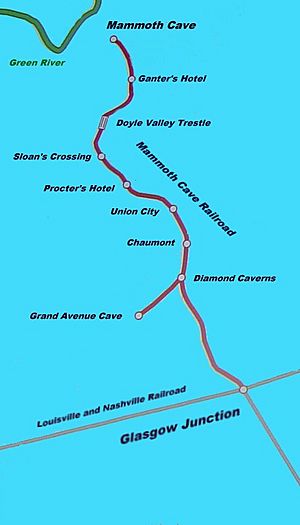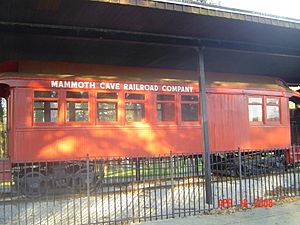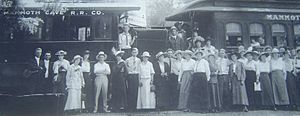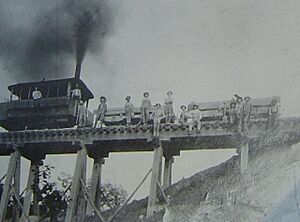Mammoth Cave Railroad facts for kids
The Mammoth Cave Railroad, also known as the "Dinkey Train," was a short train line in Kentucky. It connected to the main Louisville and Nashville Railroad (L&N) and took visitors to the famous Mammoth Caves. This small railroad was about 9-mile (14 km) long, running from Glasgow Junction (now Park City) to Mammoth Caves.
The Dinkey Train started running in 1886 and operated for 45 years. It was a simple train, usually made up of just two parts: a special "dummy" steam locomotive and a wooden passenger coach. This train carried people and their bags to the caves. Along the way, it made several stops, including places like Diamond Caverns and Sloan's Crossing. The Dinkey Train could travel at speeds of 25 to 35 miles per hour on its light rails.
History of the Dinkey Train
Before the Dinkey Train existed, many people visited Mammoth Caves. Between the end of the American Civil War and 1880, about 40,000 to 50,000 passengers each year would arrive at Glasgow Junction by the L&N Railroad. From there, they would take a stagecoach to Mammoth Caves. Colonel Larkin J. Procter owned this stagecoach service and also ran the Mammoth Cave Hotel.
The L&N Railroad owned the rights to build a railway to Mammoth Cave. However, the Mammoth Cave Railroad was not built by the L&N itself. In 1874, Colonel Procter, his brother George, and other investors created the Mammoth Cave Railroad company. They leased the railroad rights from the L&N for 25 years.
The new railroad company bought four used "dummy" steam engines. These engines had previously been used on street railways in cities like Memphis and Nashville, Tennessee. They also got two wooden passenger coaches and two combination cars that carried both passengers and luggage. Usually, two Dinkey Trains would be running at any given time. The passenger cars had open areas at the ends and were heated by a coal stove. They were always painted red.
Work on the railroad began in 1880, with the first short section going to Diamond Cave. Construction stopped for a while but started again in July 1886. The railroad officially opened for business in November 1886. A ticket cost $3 when it first started. The first passenger, W. F. Richardson, was recorded in the Mammoth Cave Hotel register on November 8, 1886.
By 1913, a full trip to Mammoth Cave, including the train ride, cave fees, hotel, and meals, cost $11.75. You could also pay extra for side trips to other caves or for a bed in a Pullman Sleeper car.
The End of the Line
The Mammoth Cave Railroad ran well from 1886 until the mid-1890s. After that, the L&N Railroad stopped supporting the line. The original owners then took full control of the company again in 1903.
The future of the railroad began to change in 1904 when a judge from Indianapolis drove the first car to the caves. Cars became more popular, which meant fewer people needed the train. The creation of the Mammoth Cave National Park in 1926 also played a role in the railroad's closing.
The Dinkey Train stopped carrying passengers on February 28, 1929. For a short time, a railcar was used to deliver mail until 1931. The railroad officially closed down permanently on August 1, 1931.
Today, you can see Baldwin steam engine number 4 and passenger coach number 2 at the Mammoth Cave National Park museum. This display is listed on the National Register of Historic Places. The old railroad line was turned into the Mammoth Cave Bike and Hike Trail in 2004. This trail currently starts at Sloans Crossing Pond, and there are plans to extend it to cover the full 9-mile (14 km) route from Park City to the Mammoth Cave National Park.
What is a "Dummy" Locomotive?
The "steam dummy" locomotive would fill up with water at Glasgow Junction before starting its 9-mile (14 km) journey. It pulled the coach up the Chester Escarpment, gaining about 200 feet (61 m) in height for every mile. The train traveled through many hills and valleys, winding its way over a trestle bridge at Doyle Valley before reaching the Mammoth Cave hotel.
The train usually had a crew of at least three people: an engineer to drive the locomotive, a boiler man to keep the engine going with fuel, and a conductor to help the passengers. Sometimes, there were as many as seven employees working on the train. On rare occasions, the train would pull extra cars besides the passenger coach. The most famous steam engine was number 4, which was nicknamed Hercules.
The small Baldwin steam locomotive was called a "dummy" because it was built to look like a regular passenger streetcar. The main reason for this design was to prevent horses from getting scared when the train came near them. Horses are often sensitive to loud noises and large machines. The "dummy" design also meant that the engine's parts, like rods, pipes, and bolts, were covered up. This made the engine look less "brutish" or industrial for city streets. These special "dummy" style steam engines used at the Mammoth Cave Railroad were originally built by the Baldwin Locomotive Works.






